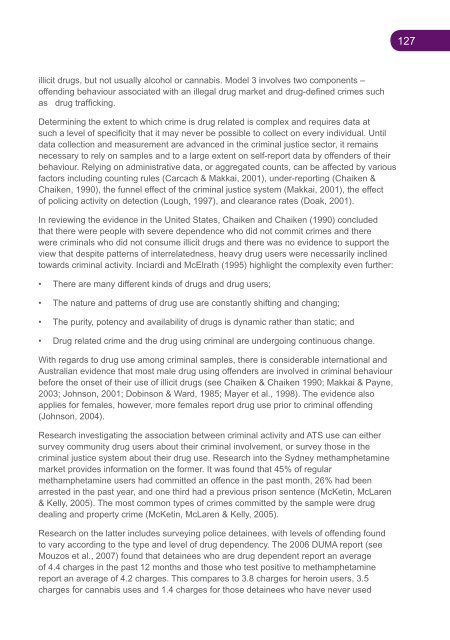National Amphetamine-Type Stimulant Strategy Background Paper
National Amphetamine-Type Stimulant Strategy Background Paper
National Amphetamine-Type Stimulant Strategy Background Paper
You also want an ePaper? Increase the reach of your titles
YUMPU automatically turns print PDFs into web optimized ePapers that Google loves.
127<br />
illicit drugs, but not usually alcohol or cannabis. Model 3 involves two components –<br />
offending behaviour associated with an illegal drug market and drug-defined crimes such<br />
as drug trafficking.<br />
Determining the extent to which crime is drug related is complex and requires data at<br />
such a level of specificity that it may never be possible to collect on every individual. Until<br />
data collection and measurement are advanced in the criminal justice sector, it remains<br />
necessary to rely on samples and to a large extent on self-report data by offenders of their<br />
behaviour. Relying on administrative data, or aggregated counts, can be affected by various<br />
factors including counting rules (Carcach & Makkai, 2001), under-reporting (Chaiken &<br />
Chaiken, 1990), the funnel effect of the criminal justice system (Makkai, 2001), the effect<br />
of policing activity on detection (Lough, 1997), and clearance rates (Doak, 2001).<br />
In reviewing the evidence in the United States, Chaiken and Chaiken (1990) concluded<br />
that there were people with severe dependence who did not commit crimes and there<br />
were criminals who did not consume illicit drugs and there was no evidence to support the<br />
view that despite patterns of interrelatedness, heavy drug users were necessarily inclined<br />
towards criminal activity. Inciardi and McElrath (1995) highlight the complexity even further:<br />
• There are many different kinds of drugs and drug users;<br />
• The nature and patterns of drug use are constantly shifting and changing;<br />
• The purity, potency and availability of drugs is dynamic rather than static; and<br />
• Drug related crime and the drug using criminal are undergoing continuous change.<br />
With regards to drug use among criminal samples, there is considerable international and<br />
Australian evidence that most male drug using offenders are involved in criminal behaviour<br />
before the onset of their use of illicit drugs (see Chaiken & Chaiken 1990; Makkai & Payne,<br />
2003; Johnson, 2001; Dobinson & Ward, 1985; Mayer et al., 1998). The evidence also<br />
applies for females, however, more females report drug use prior to criminal offending<br />
(Johnson, 2004).<br />
Research investigating the association between criminal activity and ATS use can either<br />
survey community drug users about their criminal involvement, or survey those in the<br />
criminal justice system about their drug use. Research into the Sydney methamphetamine<br />
market provides information on the former. It was found that 45% of regular<br />
methamphetamine users had committed an offence in the past month, 26% had been<br />
arrested in the past year, and one third had a previous prison sentence (McKetin, McLaren<br />
& Kelly, 2005). The most common types of crimes committed by the sample were drug<br />
dealing and property crime (McKetin, McLaren & Kelly, 2005).<br />
Research on the latter includes surveying police detainees, with levels of offending found<br />
to vary according to the type and level of drug dependency. The 2006 DUMA report (see<br />
Mouzos et al., 2007) found that detainees who are drug dependent report an average<br />
of 4.4 charges in the past 12 months and those who test positive to methamphetamine<br />
report an average of 4.2 charges. This compares to 3.8 charges for heroin users, 3.5<br />
charges for cannabis uses and 1.4 charges for those detainees who have never used

















